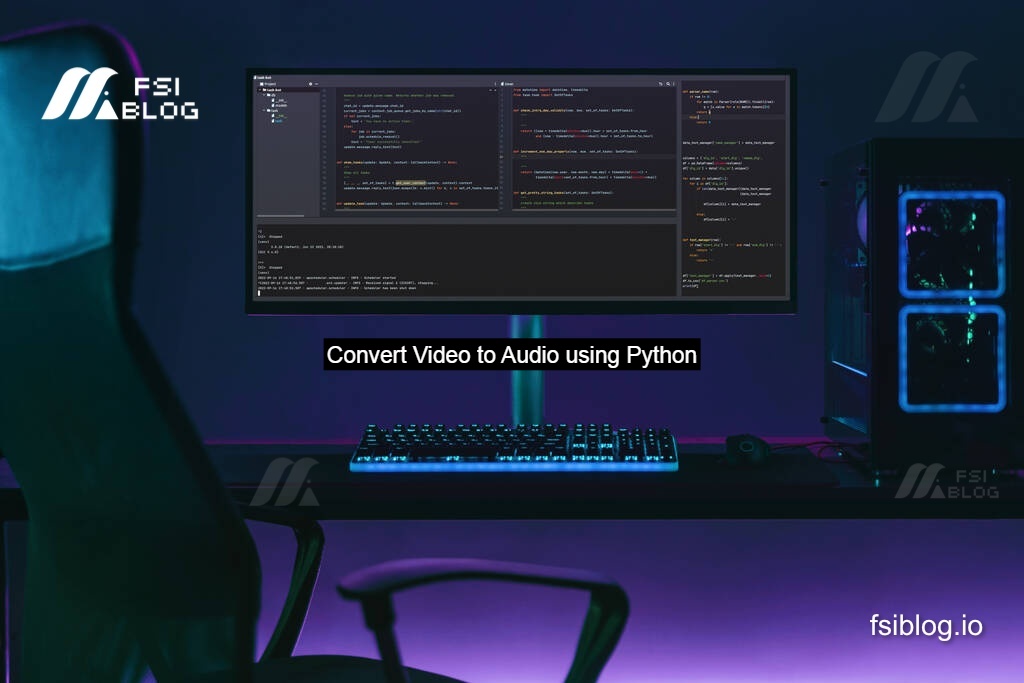Convert Video to Audio using Python

I’m excited to share something from my recent project work that i have you ever needed to extract audio from a video file maybe to save a podcast, isolate a soundtrack, or analyze audio content well, I recently tackled this challenge, and I discovered just how easy it is to do with Python. Using the awesome MoviePy library, I managed to convert video files to audio formats like MP3 in just a few simple steps. Let me walk you through the process it’s quick, efficient, and super satisfying to see the results!
In the digital world, where audio and video are essential forms of communication, it’s often helpful to extract audio from video files. Whether it’s for creating podcasts, saving music tracks, or analyzing audio content, converting video to audio is a common requirement. The good news is that Python makes this task super easy with the MoviePy library. In this guide, we’ll walk you through the process of converting video files to audio formats like MP3.
Installation:
Before diving into the code, ensure you have the following:
- Python Installed: Download and install Python from python.org if you don’t have it already.
- MoviePy Library: Install the MoviePy library, a versatile library for video editing tasks.
To install MoviePy, open your terminal or command prompt and type:
codepip install moviepy
Code Explanation:
Here’s the Python script that handles video-to-audio conversion:
code# Import the required module
import moviepy.editor
# Step 1: Read the video file
video = moviepy.editor.VideoFileClip('video_name.mp4')
# Step 2: Extract the audio from the video
audio = video.audio
# Step 3: Save the audio to a file
audio.write_audiofile('audio_name.mp3')
Load the mp4 file:
- Importing the Library: The
moviepy.editormodule is the key to handling video and audio manipulation. Ensure this library is installed before running the script. - Reading the Video File:pythonCopy code
video = moviepy.editor.VideoFileClip('video_name.mp4')Replace'video_name.mp4'with the actual name of your video file. This line creates aVideoFileClipobject that represents your video file. - Extracting the Audio:pythonCopy code
audio = video.audioTheaudioattribute of theVideoFileClipobject allows you to extract the audio stream. - Saving the Audio:pythonCopy code
audio.write_audiofile('audio_name.mp3')Replace'audio_name.mp3'with the desired name of your output audio file. This step saves the extracted audio in MP3 format.
Benefits of Using Python for Video-to-Audio Conversion
- Automation: Convert multiple videos to audio in bulk with minimal effort.
- Flexibility: Customize the code for additional features like trimming or adding effects.
- Open Source: MoviePy is free and open-source, making it a great tool for developers.
Final code:
Here’s how you can convert multiple videos in a directory to audio files:
codeimport moviepy.editor
import os
# Directory containing videos
video_directory = './videos'
# Loop through all files in the directory
for file_name in os.listdir(video_directory):
if file_name.endswith('.mp4'): # Check if the file is a video
video_path = os.path.join(video_directory, file_name)
video = moviepy.editor.VideoFileClip(video_path)
# Generate audio file name
audio_name = os.path.splitext(file_name)[0] + '.mp3'
audio_path = os.path.join(video_directory, audio_name)
# Save the audio file
video.audio.write_audiofile(audio_path)
